SAFElink Alliance and the Trimble Supervisor System
The SAFElink Alliance project heavily utilised machine control technologies and had a number of unique challenges including field reference on a pegless site. These challenges were overcome with the help of GPS Supervisor Systems.
Published: 23rd February 2009
Author: Steed Shepherd - Machine Control Manager, SAFElink Alliance
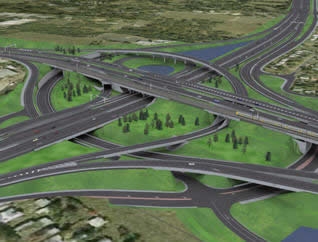
Overview of the SafeLink Alliance Project
The SAFElink Alliance is a joint venture between the Queensland Government's Department of Main Roads; construction companies Leighton Contractors and BMD Constructions; and design firms Maunsell Australia and Arup, all joining forces to deliver the Ipswich Motorway Upgrade: Wacol to Darra project.
The project is an $AU700 million highway construction job located in Brisbane, Australia. It involves upgrading 7.6km (4.7mi) of two multi-lane motorways; a new multi-level interchange system; a new rail formation through the interchange that will join at either end to an expanding public transport system; over 5km (3.1mi) of new service roads; 26 bridge structures; as well as a new outdoor sporting complex and numerous pedestrian and cycle paths. The work involves moving approx 1.4 million cubic metres of bulk earthworks and over 420,000 tonnes of asphalt.
The Queensland Government is delivering a record $AU16.2 billion road implementation program over the next five years and this project is a significant part of that program. With south east Queensland currently experiencing a significant economic boom period and rapid population growth, much of this funding has been invested in large scale projects designed to open up already congested traffic routes in order to promote new residential communities throughout the region.
The sheer number of large-scale construction projects in south-east Queensland's relatively small geographical area has resulted in a skills shortage in all segments of the construction industry. This includes the availability of surveyors and qualified field supervisors, especially those with the ability to read and interpret design drawings. This skill shortage coupled with SAFElink Alliance's vision of best practice and commitment to safety has resulted in a re-think of the traditional construction methods.
SAFElink Alliance employs the use of Trimble machine control across all work areas. The project utilises twenty GPS-guided machines including excavators, pad-foot compactors, bulldozers, smooth-drum vibrating rollers and seven graders that are able to switch between GPS and UTS guidance.
SAFElink Alliance still has quite a number of traditional survey crews on site. The project operates with eight field crews along with three surveyors that split their time between office and field and two full-time office surveyors.
Some of these crews are dedicated completely to bridge and wall structures (for which no machine control is used). Their involvement with the earthworks side of the job is largely limited to topographical pick-ups and quality assurance checks along with the set-out of objects that occur after the machine control has left such as kerb and channel, concrete barriers, road furniture and line-marking.
Thus, with the widespread use of machine control replacing traditional survey methods in bulk earthwork operations, SAFElink Alliance has gone a long way towards creating a pegless site. The site relies heavily on the use of 3D guidance methods rather than the rows of batter boards and survey stakes that line traditional work areas.
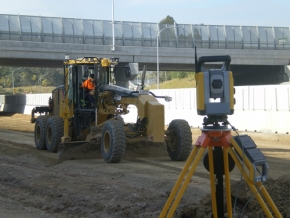
Image - UTS Grader
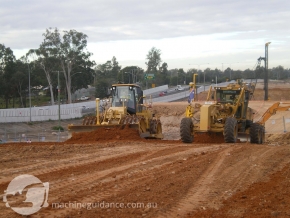
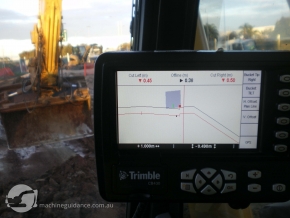
Image - Inside GPS Excavator

Challenges

The Challenge of a Pegless Site (1)
The Challenge of a Pegless Site
The move to a pegless site presented SAFElink Alliance with its first and biggest problem. While a pegless site has certainly helped streamline the survey operations of the project, it did pose a significant challenge to the supervisors responsible for overseeing on site operations. With no survey marks available to them, the field supervisors were effectively working in the dark - struggling to visualise what they were trying to build. In fact, instead of the supervisors, the actual machine operators now had all the design information at their fingertips.
Therefore if the Alliance was going to try to keep the site pegless, it was necessary to find a solution that allowed the field supervisors access to the same design information as the machine operators. This is where the Trimble SCS900 Supervisor System really came into its own.
As part of their day-to-day job, the field supervisors are constantly driving up and down the job site. By installing the Supervisor System into their site vehicle with the screen display mounted on the windscreen, supervisors now have access to both basic cut/fill levels as well as long-section and cross-section information, displayed right in front of the operator and covering every millimetre of the road works. With just some basic system training, supervisors are now empowered with the information they require to both visualise the job and check on the progress of the equipment under their supervision.
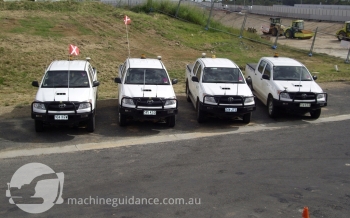
The Challenge of a Pegless Site (2)
SAFElink Alliance originally tested the Supervisor Kits by having one system available to the whole job on an as-required basis. However, it was such a popular item that within weeks each work area had their own dedicated SCS900 Supervisor Kit assigned to a vehicle in that area. The individual vehicles are generally driven by the leading hand who is the main field contact and always on site, but the foreman or engineers are able to use the vehicles as required. The supervisor vehicles are also equipped with roof-mounted flags so that if anyone on the ground requires a level, they can simply wave down one of these flagged vehicles for an instant update.
The same problems of a pegless site also apply to client inspectors. These State Government representatives are often required to come on site and inspect various aspects of the works. This is a difficult task when there are no pegs to reference and very little design information available. To combat this, the Alliance decided to purchase extra Trimble SCS900 Supervisor Kits and fit these to the client inspector vehicles. Now, in the same way as the supervisors and engineers do, the client representatives can drive anywhere throughout the site and gain real-time information on the progress of the works.
As well as this, client inspectors who often inspect multiple sites around the local area are able to obtain design information from any other Trimble-equipped project in the same manner. This empowers the client to inspect on site operations at any stage with minimal disruption to field crews.
The SAFElink Alliance site currently utilises seven SCS900 Supervisor Systems, split between field supervisor crews, engineers and client inspectors. On top of this, many of the field survey crews have special brackets that allow them to mount their SPS881 Rovers to the outside of their vehicles and effectively create their own Supervisor System when required.

Changing Designs
The second challenge encountered on the SAFElink Alliance project was related to the design itself. As both the client and the designers are part of the Alliance venture, the roadwork design is continually being refined and updated as the project progresses. The consequence of this is that any design drawings that were available to the field were continuously being superseded and there was real risk of an intended design change being missed in the field.
This was also true of any survey marks that had been set-out in the field. When a design was changed the pegs became inaccurate until the survey crews were available to re-mark (or completely remove) them. Indeed, you would need an army of surveyors available if they were required to update all changes in designs instantaneously.
However, by using the SCS900 Supervisor System in replacement of survey pegs, the design changes are electronically updated into the system in the same manner as survey crews' controllers, making any design change almost instantaneous. The operator merely needs to bring the SCS900 Tablet into the survey office to synchronize with the designs folder, or if necessary, the new design can be uploaded in the field via USB transfer.

Confined Working Spaces (1)
Confined Working Spaces
The third obstacle encountered at SAFElink Alliance is the difficulty of access within confined spaces around the jobsite. Much of the works are alongside existing motorway and one of the prerequisites of the project is that the traffic reliability and existing traffic routes are to be maintained during construction. Because the cut and the fill operations are often separated by live motorways, earth is moved using truck and dogs. This results in continuous rounds of road trucks coupled with heavy earthworks machinery, all working in confined spaces that are difficult to access.
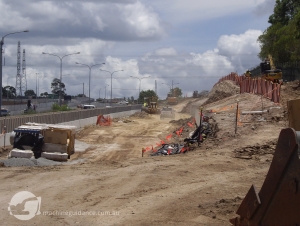
Confined Working Spaces (2)
Confined Working Spaces
There is an obvious safety concern with surveyors or supervisors walking around in such conditions. The project is very conscious of safety matters, as is evident in the "SAFElink" name and maintaining a safe working environment is the top priority of the Alliance.
This confined environment also makes any peg set-out difficult to maintain. With so much construction activity and heavy vehicle movements, any pegs that are on the ground are destined to soon lie flat on their side.
But with the SCS900 Supervisor System mounted on top of site vehicles, the operator is able to quickly and easily acquire real-time information and provide that to others in the field, all without leaving the relative safety of their vehicle. This is undoubtedly safer than surveyors needing to be on the ground trying to sledgehammer pegs whilst dodging trucks - and is also safer than foreman and general earthworks crews having to be on the ground to read and utilise the pegs.

Challenges Overcome
Challenges Overcome
Thus the SCS900 Supervisor System has helped solve a number of potential on site problems. It has helped facilitate the use of a pegless site by empowering field supervisors, engineers and client representatives with the required design information previously held exclusively by survey crews and/or machine control operators. The system has also ensured that the latest designs can be instantaneously updated in the field and has helped improve safety on the project by reducing the need for on the ground set-out and string-lining.

Extra Benefits
In addition to solving these challenges, there have been more than a few added benefits that have been gained from using the SCS900 Supervisor Systems, mainly arising out of the fact that field supervisors have instant access to valuable information that can help in both planned and unplanned works.

Forward Planning
Forward Planning
The first of these benefits is that everyone - surveyors, supervisors and machine-guidance operators - are all working with the same information.
Because everyone has a similar knowledge of the job, all the information is readily available for supervisors to be able to forward plan their works. No longer does the leading hand or foreman need to spend time liaising with designers and surveyors and waiting for the required information. They can now quickly and easily access information for the entire job and plan their forward works accordingly.

Unplanned Works
Unplanned Works
Another benefit that has arisen from utilising the Supervisor Systems is the ability for field crews to work without the need to wait for surveyors. Especially useful for unplanned works, the supervisor now has the ability to commence basic works prior to survey set-out or without machine control. This includes the ability to start topsoil strips and cut/fill operations.
It has also helped with on site planning of basic infrastructure such as haul road positions, site compound locations and temporary drainage requirements. These tasks can be commenced, if not completely accomplished using the SCS900 Supervisor System without the need for booking survey crews or GPS machinery.
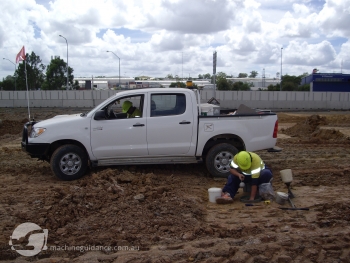
Less Reliance on Survey (2)
Less Reliance on Survey
The SCS900 Kits have allowed supervisors to take responsibility of basic, yet time-intensive survey tasks. Using the Supervisor Kits, leading hands can easily record significant locations such as soil tests. They can also perform other relatively simple survey tasks whilst on site like picking-up bulk earthwork levels. This allows more efficient use of valuable survey crew time.
The supervisor is also able to easily perform basic volume calculations in the field. Even if they are not comfortable with the Cogo functions in SCS900, the supervisor can easily determine basic surface area and cut/fill measurements. This can be used for simple calculations in order to help determine whether more material is required and assist more efficient on site plant management.
A further unexpected advantage of using the SCS900 Supervisor System is that SAFElink Alliance has effectively developed a whole team of quasi field surveyors. At times when basic survey tasks are required but no surveyor is available, a supervisor that is familiar with the system is able to borrow a traditional survey rover and operate it with a fair amount of confidence. The SAFElink Alliance project has even had leading hands and engineers working on night shift with the ability to perform basic survey pick-ups and set-outs rather than needing a surveyor to sacrifice two day shifts for what is a relatively simple task at night.

SCS900 in the Office
SCS900 in the Office
When back in the office, the supervisors can also take advantage of the SCS900 PC Simulator. The simulator is easily installed onto any computer and the supervisor simply uses their current knowledge of the system to run it, effectively "walking the job" in the office. Earthworks supervisors can even be found firing up the PC Simulator rather than reaching for design drawings when trying to visualise the project or explain something to engineers or subcontract suppliers.

Closer Relationships
Closer Relationships
Another somewhat unexpected benefit of giving field supervisors access to traditional survey information is the closer working relationship that has developed between the two groups. Traditionally in the Australian construction environment, surveyors do not get involved with any earthworks planning; they are largely removed from the earthworks operation and responsible purely for setting out the intended design and then checking completed works against the design. SAFElink Alliance surveyors have found that they are now working closer with the field crews, which has helped open up communications between crews.

Cost Benefits
It is certain that the Trimble SCS900 Supervisor Kits have produced some project savings, although putting real figures on this is somewhat difficult. If required to peg the job in order to provide a reference for field supervisors, a conservative estimate would require the employment of at least one extra survey crew for each of the four major work areas.
Comparing the cost of the Trimble Supervisor Systems purely against what would be required in the extra survey crew wages and required equipment over the three year length of the project, the estimated project saving is in the $AU4 million range. This does not include the cost of the survey stakes that would be required nor the cost of hardcopy drawings that the supervisors would need to carry with them for reference.
It should be noted that SAFElink Alliance has also invested over $AU2 million in machine control guidance. This investment has not come into the above equation because the machine guidance was already being used on site. The cost savings are merely a comparison of employing surveyors to peg the job for the sole purpose of being used as a reference by supervisors (which was requested at one stage of the project) versus the use of the SCS900 Supervisor System as a referencing system.
All this being said, the biggest cost saving to the project would have to be the increased job satisfaction, which in turn results in less staff turnover. Because of all the benefits mentioned above, the field supervisor has become more involved with the project and is taking more pride and ownership of their section of the job. Engineers and office staff are realising that the field supervisors are fast becoming very valuable employees and are putting greater trust in their leading hands to get things right. Similarly, as the survey crews are performing less of the manual and repetitive task of pegging, they too are able to move on to more satisfying tasks, increasing their job satisfaction.

Conclusion
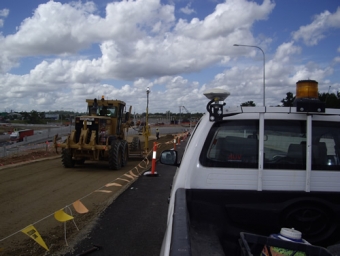
Conclusion (2)
The Trimble SCS900 Supervisor System has become an integral part of the works on the SAFElink Alliance project. The system works perfectly in conjunction with machine control guidance as a way of empowering users with information previously held exclusively by survey crews and machine operators.
The SCS900 Supervisor System has also provided solutions to many other construction challenges. The instant electronic update of designs helps to ensure that all amendments are quickly and easily transferred to the field. The very nature of the system being installed into a vehicle and all design information being available without needing to step out of a site vehicle also has enormous safety benefits.
Furthermore, the SCS900 Supervisor System also allows users access to information that can assist in planning future works and helps field crews react to unplanned works without the need to wait for surveyors or machine-guidance. It also reduces the reliance on traditional survey crews, allowing on site users to assume responsibility of basic survey tasks and facilitates simple field calculations in order to more efficiently control resources such as plant and material ordering. Sharing the survey tasks between crews also helps with team bonding and individual job satisfaction as well as creating individuals that become more valuable to the project as a whole.
Additionally, there is a significant cost saving for SAFElink Alliance with the use of the Trimble SCS900 Supervisor Systems in comparison to what would be required in extra crew costs over the life of the project.

Return to Articles Menu


